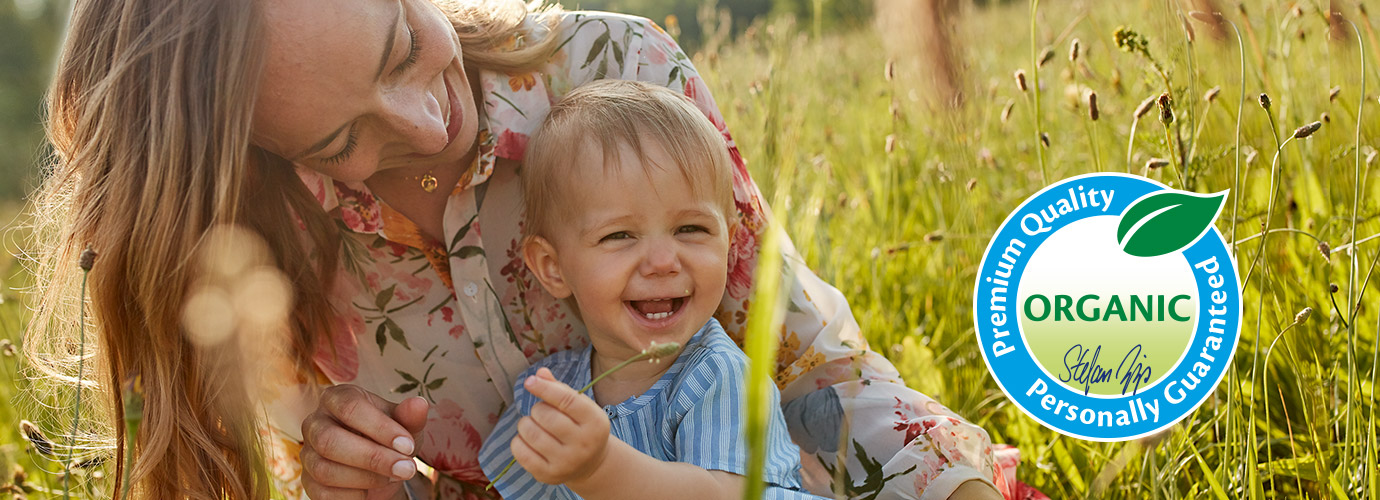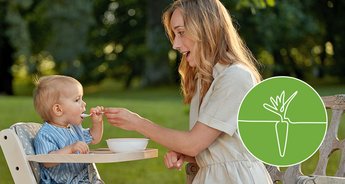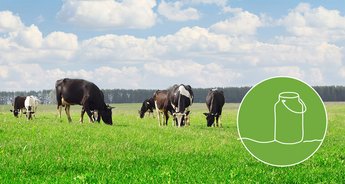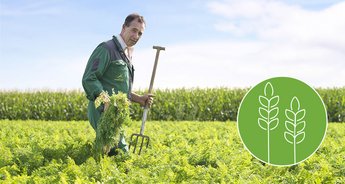HiPP goes beyond Organic
HiPP’s organic seal guarantees the highest quality and exceeds legal EU requirements. But which standards does HiPP go beyond? What does the HiPP Organic Seal stand for and why is organic quality so important for children’s health?
Why is HiPP using organic ingredients?
Organic versus conventional farming
HiPP Organic Seal
10 questions on organic farming and sustainability
Why is HiPP using organic ingredients?

For more than 60 years, the family-owned company HiPP has been producing organic baby food. HiPP was swimming against the tide at the time and also faced great resistance as we developed our organic farming practices. However, by putting our heart and soul into it, we managed to set new standards for baby food and beyond.
HiPP’s organic contract farmers feed and keep their animals in a species-appropriate manner. When it comes to our farming methods, environmentally friendly crop protection, natural fertilisation as well as maintaining soil fertility are our top priorities. This way, we are able to produce foods that are both sustainable and environmentally sound.
Organic versus conventional farming
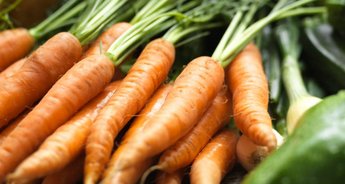
Advantages of organic farming compared to conventional farming:
- More sustainability
- Improving animal health, reducing antibiotics resistance
- Greater biodiversity both in and above the ground
- Greater diversity of functional groups (herbivores, pollinators, predators and producers)
- Better soil quality, less erosion, lower environmental impact
- Lower nutrient losses, fewer greenhouse gas emissions
- Greater energy efficiency
HiPP Organic Seal
Long before official regulations on organic farming came into effect, HiPP – a pioneer of organic farming – paved the way for the organic baby food boom. To this day, the HiPP Organic Seal stands for measures that HiPP has been committed to implementing for decades.
Organic raw materials are beneficial for children’s health
The younger someone is, the more sensitive they are: Pesticides and heavy metals have a particularly strong influence on the growing organism.
Our natural dairy ingredients – in the best organic quality
Our milk is sourced from farms that follow our HiPP Organic Farming Guidelines. For 30 years, HiPP has been producing without the use of chemically synthesised pesticides or genetic engineering.
Organic Farming
Organic farmers do not use any chemically synthesised pesticides. Organic farming practices also protect the groundwater and the climate.
Sustainability as a corporate philosophy
Our sustainability management focuses on the company as a whole and the entire value chain.
10 questions on organic farming and sustainability
1. Agriculture: Why go organic? What is organic farming and why does it matter?
2. What exactly are pesticides?
3. How are the fields fertilised according to organic farming practices?
4. Effects of synthetic pesticides: Do they also have an impact on humans? Who is particularly at risk and why?
5. How does organic animal husbandry look, and can antibiotics be used on the animals?
6. Are organic foods more nutritious?
7. Why does HiPP have its own organic seal?
8. Does organic farming equal sustainable farming?
9. Biodiversity/species conservation – How does organic farming contribute and what is HiPP doing to preserve our biodiversity?
10. Why is genetic engineering not used in organic farming?
1. Agriculture: Why go organic? What is organic farming and why does it matter?
Organic farming means working the land in harmony with nature. This includes respecting the cycles of nature and dealing responsibly with energy resources and natural resources. A good example of organic circular agriculture is the combination of crop cultivation with animal husbandry. This means that farms only keep the number of animals that they can feed with what they produce, and that the manure from the animals is used to fertilise the lands in a manner that does not overwhelm the soils.1
Another important pillar of organic farming is the preservation and improvement of soil fertility in order to maintain the overall circularity. Not using any synthetic sprays (synthetic pesticides) or easily soluble mineral fertilisers is also essential. This not only protects soils and waters, but also insects and other beneficial organisms. Instead, long-term soil fertility is ensured through humus formation, multi-year crop rotation, and the use of nitrogen-fixing crops. This is how organic agriculture contributes to climate protection, species protection and resource conservation.
Figure 1 shows very well how intertwined these different segments of organic farming are.
Another relevant piece of information for consumers: Less pesticide residue can be found in organic foods as compared to conventionally produced foods.2 To find out what that means exactly, read the answer to question 4.
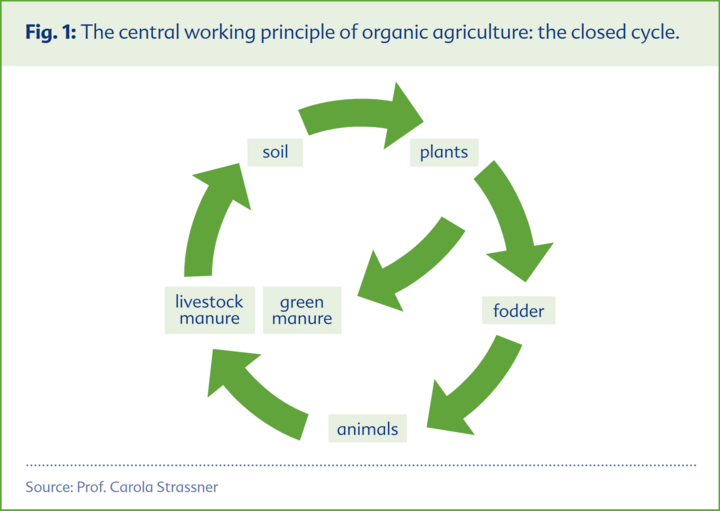
2. What exactly are pesticides?
Pesticides are substances that are primarily used to keep the crops healthy and to prevent them from being destroyed by pests or disease.3
Pesticides are grouped according to their respective area of application. They are categorised as insecticides (against insects), herbicides (against plants, such as weeds) and fungicides (against fungi). Synthetic pesticides are based on various artificially produced substances or combinations thereof, which have a toxic effect on the respective organisms. However, most pesticides affect not only harmful organisms but also other plants and animals, including beneficial ones. The active substances in pesticides can also accumulate in the food chain or pollute bodies of water, including our groundwater. As a result, pesticides can ultimately impact humans and their immediate environment as well.2,4
3. How are the fields fertilised according to organic farming practices?
In organic farming, nutrients are added to the soil by promoting humus formation and by use of organic and mineral fertilisers.
Humus is formed by growing nutrient-fixing plants like lupines, peas or various types of clover between the main crops (cover crops). The nutrient-rich plant residues are worked into the ground, thereby enriching the soil with important nutrients such as nitrogen.
Organic fertilisation means the application of liquid manure and slurry. The amount of manure available depends on the number of animals that can be kept on the farm’s lands. Whenever necessary, mineral fertilisers may also be used. This includes phosphorus, rock dust and lime as well as naturally occurring minerals such as sulphur and other micronutrients.5
These measures also help the plants remain resistant to pests and plant diseases, which in conventional agriculture are often controlled using synthetic pesticides.
4. Effects of synthetic pesticides: Do they also have an impact on humans? Who is particularly at risk and why?
Synthetic pesticides can have an impact on us humans. Particularly vulnerable groups are foetuses, infants and toddlers. Pesticides can be absorbed through the mother’s placenta and subsequently harm the foetus, whose body and organs are not yet fully developed. The body and organs of infants and young children are also not yet mature. This means that their bodies produce fewer enzymes which break down such pollutants. Given their lower body weight as compared to adults, the concentration of pollutants in their bodies is also higher. All of this makes them more vulnerable.3 Possible health effects of excessive pesticide concentration in children include obesity, metabolic disorders, cognitive impairment, developmental delays, respiratory disorders and ADHD. 6,7,8,9,10
5. How does organic animal husbandry look, and can antibiotics be used on the animals?
The number of animals kept on organic farms always depends on the amount of land available (see question 1: Why go organic?). Organic chickens, cattle and pigs get to enjoy more space in the barn and pasture, and get to spend more time outdoors than animals on conventional farms. On organic farms, the animals should have the opportunity to engage in natural behavioural activities. Pigs should, for example, have straw covered areas, where they can indulge in their innate rooting behaviour. Medication such as antibiotics must not be used as a preventive measure, but only if it is absolutely necessary for the animal’s recovery. Prior to such a therapy, all natural remedies, such as herbal and homeopathic alternatives, should be exhausted.11
6. Are organic foods more nutritious?
Some studies have shown that organic foods contain higher levels of certain nutrients as compared to their conventional counterparts. This has been shown for secondary plant metabolites such as phenolic acid12 and micronutrients such as iron and zinc11. Higher levels of omega-3 fatty acids have been found in milk13 and meat14. This nutrient is generally known as the “good” fatty acid and can prevent cardiovascular diseases.
It should be noted, however, that although higher levels of these nutrients have been detected in organic foods, no clinically relevant effect could be attributed.
7. Why does HiPP have its own organic seal?
We bring more than 60 years of experience in organic farming to the table, which we continue to build on. What makes our own HiPP Organic Seal special? Our standards for organic production by far exceed the EU’s legal requirements. Our seal builds on stricter limits for pollutants. This means, for example, that every jar has to pass at least 260 checks and is scanned for up to 1200 residues and contaminants by our laboratories. Moreover, our jars are produced in a climate-positive manner, meaning that we give back to nature. HiPP offsets significantly more carbon than it generates along the value chain all the way to the retailers – from the production of raw materials, packaging and shipping before, during and after production. Our animal welfare guidelines include the prohibition of using veterinary drugs that may lead to residues in the animal product and longer waiting periods after the use of permitted medication. Our HiPP Organic Seal also guarantees that we keep transport times as short as possible for our animals and that no electric prods are used on them.
8. Does organic farming equal sustainable farming?
Organic farming is highly resource-friendly and environmentally compatible. This can be quantified by parameters such as greenhouse gas emissions, soil quality, biodiversity, and environmental pollution, as well as residual pesticide levels in the finished food items. If environmental effects were translated into monetary values according to true cost accounting, the costs of organically produced foods would prove more cost-effective than their conventional counterparts.
9. Biodiversity/species conservation – How does organic farming contribute and what is HiPP doing to preserve our biodiversity?
Organic agriculture contributes significantly to the preservation of biodiversity and species diversity15, which is due in particular to the exclusion of synthetic pesticides, synthetic nitrogen fertilisers as well as highly soluble phosphorus fertilisers. Healthy organic farmland also serves as a wildlife refuge and creates new habitats for various insects.
HiPP does practical research on potential methods at the family-owned Ehrensberger Hof farm near Pfaffenhofen in Bavaria, Germany. Methods and practices that have proven successful are then applied at the 8,000+ organic farms that supply HiPP with raw materials. By rearing old species, HiPP further promotes genetic diversity. For example, at the HiPP model farm we raise original Braunvieh cattle, of which there are only a few hundred animals left.
10. Why is genetic engineering not used in organic farming?
Genetic engineering contradicts one of the main principles of organic farming, which is to respect the cycles of nature that cannot be arbitrarily changed. In contrast to natural breeding, where closely or very closely related species are hybridised, genetic engineering aims at transferring certain gene segments across species boundaries. The spread and multiplication of GMOs is difficult to control, which can also lead to contamination of the genetic material of natural plants. The proclaimed benefits of genetic engineering, from lower pesticide use to higher yields, have not yet been demonstrated. In contrast, organic farming aims at the more sustainable solution of natural breeding.16
References
1 BOLW (2021) Was ist ökologische Landwirtschaft? Available at:
www.boelw.de/service/bio-faq/landwirtschaft/artikel/was-ist-oekologische-landwirtschaft/.
retrieved on: 23.09.2021
2 Umweltbundesamt (2020) Pestizide. Available at:
www.umweltbundesamt.de/themen/chemikalien/pflanzenschutzmittel
retrieved on: 23.09.2021
3 EFSA (2021). Pestizide. Available at:
www.efsa.europa.eu/de/topics/topic/pesticides
retrieved on: 23.09.2021
4 Greenpeace (2015). Pestizide und unsere Gesundheit. Die Sorge wächst. Available at:
www.weltagrarbericht.de/fileadmin/files/weltagrarbericht/Weltagrarbericht/ Gesundheit/2015GreenpeacePestizide.pdf
retrieved on: 23.09.2021
5 BOLW. Düngung im Ökolandbau. 2021. Available at:
www.boelw.de/themen/pflanze/duengung/
retrieved on: 23.09.2021
6 Debost-Legrand, A. et al. (2016). Prenatal exposure to persistent organic pollutants and organophosphate pesticides, and markers of glucose metabolism at birth. Environmental research, 146, 207–217.
7 Butler-Dawson, J. et al. (2016). Organophosphorus pesticide exposure and neurobehavioral performance in Latino children living in an orchard community. Neurotoxicology, 53, 165–172.
8 Gunier, R. B. et al. (2017). Prenatal Residential Proximity to Agricultural Pesticide Use and IQ in 7-Year-Old Children. Environmental health perspectives, 125(5)
9 Bouchard, M. F. et al. (2011). Prenatal exposure to organophosphate pesticides and IQ in 7-year-old children. Environmental health perspectives, 119(8),
10 Raanan, R. et al. (2015). Early-life exposure to organophosphate pesticides and pediatric respiratory symptoms in the CHAMACOS cohort. Environmental health perspectives, 123(2), 179–185.
11 Tiergesundheit in der Öko-Landwirtschaft. BOLW. Available at:
www.boelw.de/themen/tier/gesundheit/
retrieved on: 23.09.2021
12 Barański, M. et al. (2014). Higher antioxidant and lower cadmium concentrations and lower incidence of pesticide residues in organically grown crops: a systematic literature review and meta-analyses. The British journal of nutrition, 112(5), 794–811.
13 Średnicka-Tober, D. et al. (2016). Higher PUFA and n-3 PUFA, conjugated linoleic acid, α-tocopherol and iron, but lower iodine and selenium concentrations in organic milk: a systematic literature review and meta- and redundancy analyses. The British journal of nutrition, 115(6), 1043–1060.
14 Średnicka-Tober, D. et al. (2016). Composition differences between organic and conventional meat: a systematic literature review and meta-analysis. The British journal of nutrition, 115(6), 994–1011.
15 Hausmann, A. et al. (2020). Toward a standardized quantitative and qualitative insect monitoring scheme. Ecology and evolution, 10(9), 4009–4020.
16 Gentechnik in der Landwirtschaft. BOLW. 2021. Available at:
www.boelw.de/themen/gentechnik/landwirtschaft/
retrieved on: 23.09.2021


